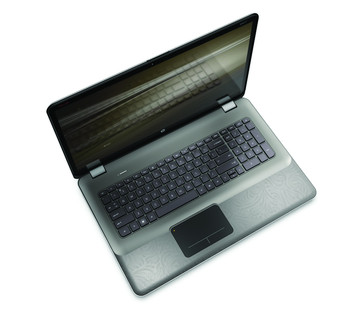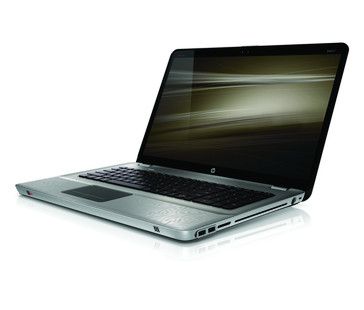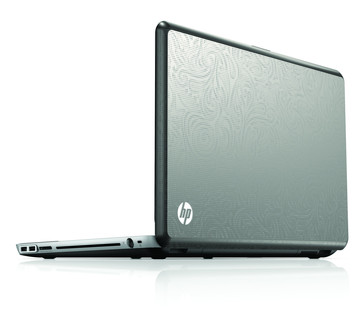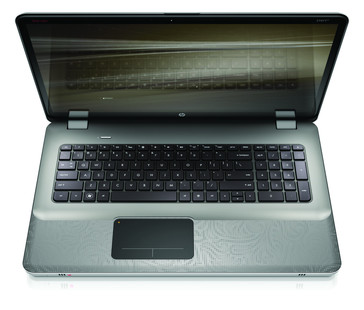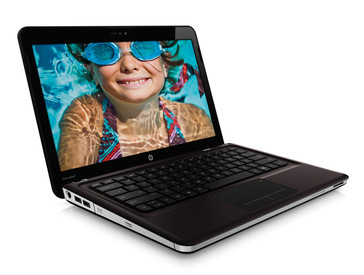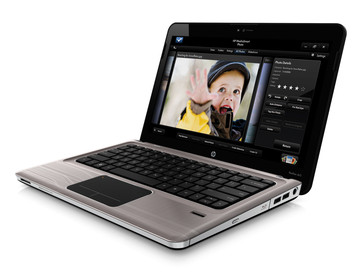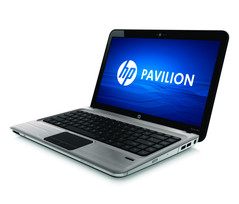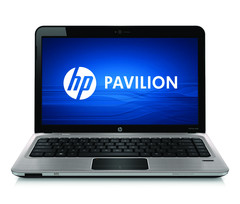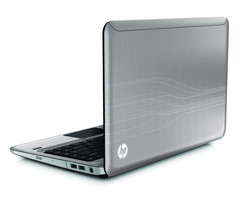NBC Onsite: HP Notebook LineUp 05/2010
by J. Simon Leitner 05/05/2010
Nvidia, no thanks?!
The notorious manufacturer Hewlett-Packard makes a comeback with a true flood of various models. Amongst the most exciting ones are the new Envy 14 and 17 models, as well as notebooks of the dv3 and dm4 series. The highlights are summarized here.
Now it was up to the native equestrian school café in Munich to supply the appropriate framework for their first press contact. Alongside young ladies riding past on proud mounts (separated by an odor-tight window, mind you), the attending journalists were first briefed comprehensively and could immediately afterwards create their own opinion of the showcased pre-samples. The weight of the handed-over press folders already suggested several innovations before the event's official start – either that or possibly a stack of scrap paper, after all?
No. Apart from a prior attunement about the design aspirations from Martin Kinne, Managing Director and VP of Personal Systems Group (PSG) of HP by trade, it went straight to the point with a whole range of products for the consumer field. One thing was striking right away: Where is the graphic card manufacturer, Nvidia? Merely one single graphic card model for the entire presented consumer array, and then even obsolete? (GeForce GT 230M) – No sign of Optimus, long live DirectX 11.0?
In following, a preliminary overview of the upcoming devices. We'll supply the according, comprehensive reviews as soon as these are available.
HP Envy 14, Envy 17
The Envy and Touchsmart notebooks/convertables, branded as "Best Lifestyle & Consumer Experience", still belong to the expensive colleagues of HP's consumer market product range.
After the launch of the first Envy models in the fall of last year (13 inch and 15 inch – here in a comprehensive review), the model range has been added to. No, that's wrong. Actually, the existing 13 and 15 inch laptops have been taken from the market and replaced by a 14 and 17 inch model. The compulsive question "why" turns up here; especially because the notebooks sold very well, according to HP (Stefan Binder, Product Lifecycle Manager HP Consumer Notebooks). Then perhaps the potent hardware components, which worked each sole case up to a proper sweat, were responsible (see our Envy 15 review). In any case, it's a fact that HP's renowned hardware – just a bit bigger – is in the just as renowned case, apart from the Intel Core i refresh.
One result is the HP Envy 14, which replaces the compacter 13 incher. The case obviously remains identical to the predecessor model. Naturally, this includes the choice of materials, which are haptically appealing surfaces of aluminum and magnesium, and give the laptop a noteworthy stability above that. Also, the "metal-etching" design is again found and supplies the display lid and wrist-rest surfaces with an attractive, individual look by means of an incorporated ornamentation.
HP doesn't mince matters in the declared notebook's specs: Thus the display allegedly has a brightness of up to 350 cd/m2, with a resolution of 1600x900 pixels. You can even be delighted about the 14 incher's computing performance – Intel's Core i3 and i5 chips (Arrendale) paired with a strong ATI Mobility Radeon HD 5650 graphic card permits expectations for a good general performance and naturally a certain extent of gaming suitability, as well.
HP has stuck to the hybrid graphic solution, which allows switching between the integrated Intel GMA HD graphic solution and the dedicated ATI graphics. This has to be prompted by the user when it's desired and doesn't automatically happen in the background, as with Nvidia's Optimus technology. Nevertheless, you can take delight in a fusion of performance and battery life – a decisive factor for a 14 inch device.
HP Envy 14
- Operating system: Windows 7 Premium 64 bit
- Processor: Intel Core i3 and i5
- Hard disk: 640 GB
- RAM: 4 GB
- Graphics: ATI Mobility Radeon HD 5650 – 1 GB DDR3, Intel GMA HD switchable
- Display: 14.5 inch HD HP Radiance Infinity display (1600x900 pixels) with LED backlight, 82% RGB color gamut
- Removable drive: Super Multi DVD ±R/RW with double layer support
- Connectivity: WLAN 802.11 a/g/n, Bluetooth integrated E/A interfaces, 2 USBs, HDMI 1.3, 1 eSATA/USB combo, 1 mini display port
- Speakers: Beats audio extension interfaces: 2 in 1 cardreader
- Webcam: HP Webcam with integrated microphone and LED light
- Weight: 2.3 kg
- Power supply: 65 W adapter
- Miscellaneous: HP Quick Web – fast browser access, mail,…
HP piles up properly in many areas with the Envy 17. As the successor of the 15 incher, the largest representative of the Premium Series is primarily tagged with the label "performance". Apart from a necessary size increase, there hasn't been much changed in comparison to its 15 inch colleague. The aluminum case presents itself as attractive and stable at the same time. It cites the same recognition features as the Envy 14, or the replaced 13 and 15 inch laptops in its looks.
And again, it gets exciting under the hood of the aluminum machine. Aside from strong Intel i5/i7 processors, a powerful Mobility Radeon HD 5850 from ATI (1GB GDDR5, VRAM) does its job in the notebook, which raises expectations for the highest graphic performance. Due to the quad-core CPU, a hybrid solution hasn't been implemented into the 17 incher, which will minimize the maximum possible battery life. The described 120 W adapter is also an indication for the extreme power appetite of the machine.
Furthermore, the given hard disk capacity of up to one terrabyte, which can likely be implemented over two HDD slots, is worth mentioning. According to HP, the maximum RAM configuration is 6 GB. Contrarily to the Envy 14, the Envy 17 also has a fast USB 3.0 port. The lack of a configuration option with a BluRay may appear strange, in particular in both of HP's premium models.
HP Envy 17
- Window 7 Premium 64 bit
- Intel Core i5 and i7
- 1 terrabyte hard disk capacity
- 6 GB RAM
- ATI Mobility Radeon HD 5850 – 1 GB DDR5
- 17.3 inch HD HP BrightView Infinity widescreen (1600x900 pixels) with LED backlight
- Super Multi DVD ±R/RW with double layer support
- WLAN 802.11 a/g/n, Bluetooth, 2 USBs, HDMI 1.3, 1 eSATA/USB combo, 1 USB 3.0 high speed, 1 mini display port
- Beats audio with subwoofer
- 5 in 1 cardreader
- HP webcam with integrated microphone and LED light
- 3.44 kg
- 120 W adapter
HP Pavilion dm4 und dv3
A main issue of the Pavilion range and the minis is the revised design. Thus, the "metal etching design" from the premium class is to also be used for the models of the lower price range. Particularly, the tm2, dv3, dm4, dv6 and the dv7 model ranges are to benefit from it. A new imprint finish for the dv6 and dv7 series' models, which are as before made of plastic, will also appear.
As to the quality of the new aluminum case, the presented HP Pavilion dv3 and dm4 were especially impressive. The laptops not only look good but also advance dangerously close to the upper range in terms of haptics. The HP Clickpad with multigesture support, as it is also used in Envy models, was also agreeable. Even if it reminds of the glass touchpad of the current MacBook generation with its size, it can't keep up with it in intuitive operating, or at least the displayed pre-samples couldn't. A particularity of the touchpad is the lack of dedicated keys. They are replaced by sensible areas at the pad's bottom edge; or rather the entire touchpad can be pressed on its lower two thirds and is consequently triggered by a click accompanied by a sensory and acoustic feedback.
In terms of performance, the mobile alternatives from the Pavilion range offer high performance CPUs from Intel as a Core i3 (dv3), as well as i5 and i7 (dv3 and dm4) chip. In view of graphics, both models fall back on the ATI Mobility Radeon HD 5450 with a 512 MB video memory. Both models have a HDMI 3.1 output and are equipped with a BluRay ROM drive.
HP Pavilion dv3 Entertainment Notebook
- Intel® Core™ i3-350M processor; 2.26 GHz, 3MB L3 cache
- 4GB DDR3 SDRAM
- 500 GB-7200 rpm
- ATI Mobility Radeon HD 5450 - DirectX 11, 512 MB dedicated graphic memory
- 33.78 cm (13.3") High-Definition HP widescreen display (1366 x 768) with LED backlight
- Windows 7 Premium 64-bit
- 10/100/1000 gigabit Ethernet LAN (RJ-45 port) integrated 802.11 b/g/n (WLAN)
- Integrated 5 in 1 reader
- 3 USB 2.0s (one of which can be used as an eSATA), 1 VGA port, HDMI 1.3, headphone-out, microphone-in
- Keyboard in island style design
- HP Clickpad with support for multi-touch gestures and on/off button
- HP Pavilion webcam with integrated microphone
- Altec Lansing audio
- 90 W AC adapter, li-ion battery with 6 cells
- 32.3 cm x 22.2 cm x 2.95 – 3.9 cm
- 2.18 kg
HP Pavilion dm4 Entertainment Notebook
- Intel® Core™ i5-450M Prozessor (2.4 GHz), 3MB l3 Cache
- 4GB DDR3 SDRAM
- 640 GB-5400 rpm
- ATI Mobility Radeon HD 5450 - DirectX 11; 512 MB dedicated graphic memory
- 35.56cm/14.0" High-Definition HP Widescreen Display (1366 x 768) with LED backlight
- Windows 7 Premium 64-bit
- 10/100/1000 gigabit Ethernet LAN (RJ-45 port) integrated 802.11 b/g/n (WLAN)
- Integrated 5 in 1 reader, 3 USB 2.0s (one of which can be used as an eSATA), 1 VGA port, HDMI, headphone-out, microphone-in
- Keyboard in island style design, HP Clickpad with support for multi-touch gestures and on/off button
- HP Pavilion webcam with integrated microphon
- Altec Lansing audio
- 90 W AC adapter, li-ion battery with 6 cells
- 34.08 cm x 22.8 cm x 2.5 – 3.22 cm
- 2.018 kg
Verdict
HP was able to astonish us several times with its line-up. For instance, the announced removal of the Envy 13 and Envy 15 models provided for skeptical looks amongst the journalists present, above all as they sold especially well, according to HP. That from now on 14 and 17 inch models are to be used is baffling because many manufacturers still state the 15 inch category, followed by the 13 inch category, as top sellers. A main issue will naturally be the new Envy's qualities – that is, what is the screen like in detail, how are heat emissions managed, and especially for the 14 incher – what does the battery life look like?
We find the extension of the "Metal Etching Design" to a majority of Pavilion consumer notebooks as positive. In regards to the quality impression, the showcased aluminum machines are out of reach for their plastic colleagues. The compact multimedia notebooks, HP dv3 and dm4, are very exciting, as they promise a good performance paired with a feasible mobility.
Finally, a note about the graphic situation of the new HP models. As already mentioned at the start, the notorious GPU manufacturer, Nvidia, is only found in one model, which is the HP Pavilion dv8. It is also one of the few devices that won't receive a facelift on its design. We doubt very much if the utilized Nvidia GT230M will be able to live up to HP's announced "High Class Entertainment". Looking at our graphic card comparison, the GPU lags far behind the ATI Radeon Mobility HD 5650, which is why the dv8 will likely be outplayed by numerous models of the dv6 and dv7 series.
And anyway, the absence of Nvidia in the current portfolio of the worldwide biggest notebook manufacturer makes us apprehensive. Was the delay of DX11 in favor of a new architecture perhaps an unfavorable move? We'll see how the product ranges of other manufacturers will develop.


 Deutsch
Deutsch English
English Español
Español Français
Français Italiano
Italiano Nederlands
Nederlands Polski
Polski Português
Português Русский
Русский Türkçe
Türkçe Svenska
Svenska Chinese
Chinese Magyar
Magyar

